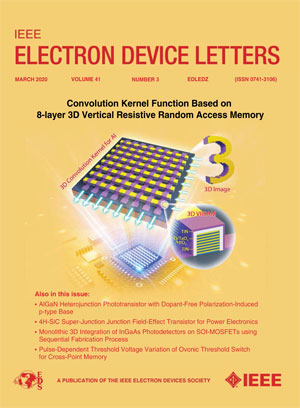AlGaN/GaN Double-Channel Ultraviolet Photodetector With Polarization-Enhanced Photoresponsivity
IF 4.1
2区 工程技术
Q2 ENGINEERING, ELECTRICAL & ELECTRONIC
引用次数: 0
Abstract
In this work, an ultraviolet photodetector (UV PD) based on an AlGaN/GaN double-channel (DC) heterostructure is demonstrated. The carriers in both channels are partially depleted by a recessed trench to suppress the dark current. A high photoresponsivity of具有偏振增强光响应性的AlGaN/GaN双通道紫外探测器
在这项工作中,展示了一种基于AlGaN/GaN双通道(DC)异质结构的紫外光电探测器(UV PD)。两个通道中的载流子被一个凹陷的沟槽部分耗尽以抑制暗电流。具有高的光响应性。在365nm光照射下,即使在3.8 $\mu $ W/ ${\ mathm {cm}}^{\mathbf{{2}}}$的低强度下,DC PD也能实现{6}{\times}{10}^{\mathbf{{4}}}$的A/W,比单通道(SC)高约30倍。此外,具有很高的比检出率。{4}{\times}{10} ^{\mathbf {{15}}}$ cm $\cdot $ ${\ mathm {Hz}}^{\mathsf {rac{{1}}{{2}}}}$ /W和相对较短的衰减时间常数为~2.3 ms。高光响应率可能与双AlGaN/GaN异质界面内极化场下光生载流子的空间分离以及穿过凹槽的光致泄漏电流有关。本工作的gan基DC PD及其机理分析可以为增强光响应性特别是弱光检测提供有价值的见解。
本文章由计算机程序翻译,如有差异,请以英文原文为准。
求助全文
约1分钟内获得全文
求助全文
来源期刊

IEEE Electron Device Letters
工程技术-工程:电子与电气
CiteScore
8.20
自引率
10.20%
发文量
551
审稿时长
1.4 months
期刊介绍:
IEEE Electron Device Letters publishes original and significant contributions relating to the theory, modeling, design, performance and reliability of electron and ion integrated circuit devices and interconnects, involving insulators, metals, organic materials, micro-plasmas, semiconductors, quantum-effect structures, vacuum devices, and emerging materials with applications in bioelectronics, biomedical electronics, computation, communications, displays, microelectromechanics, imaging, micro-actuators, nanoelectronics, optoelectronics, photovoltaics, power ICs and micro-sensors.
 求助内容:
求助内容: 应助结果提醒方式:
应助结果提醒方式:


